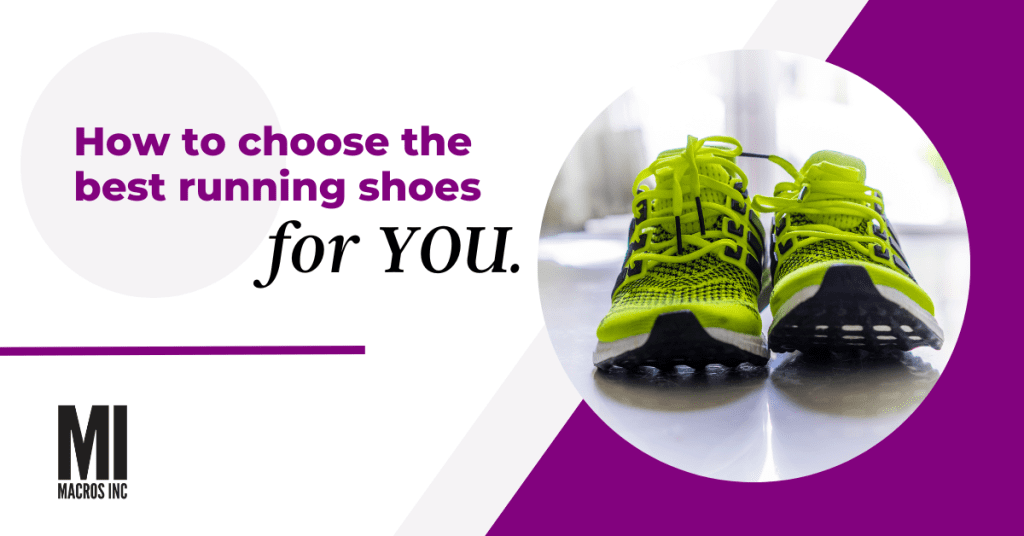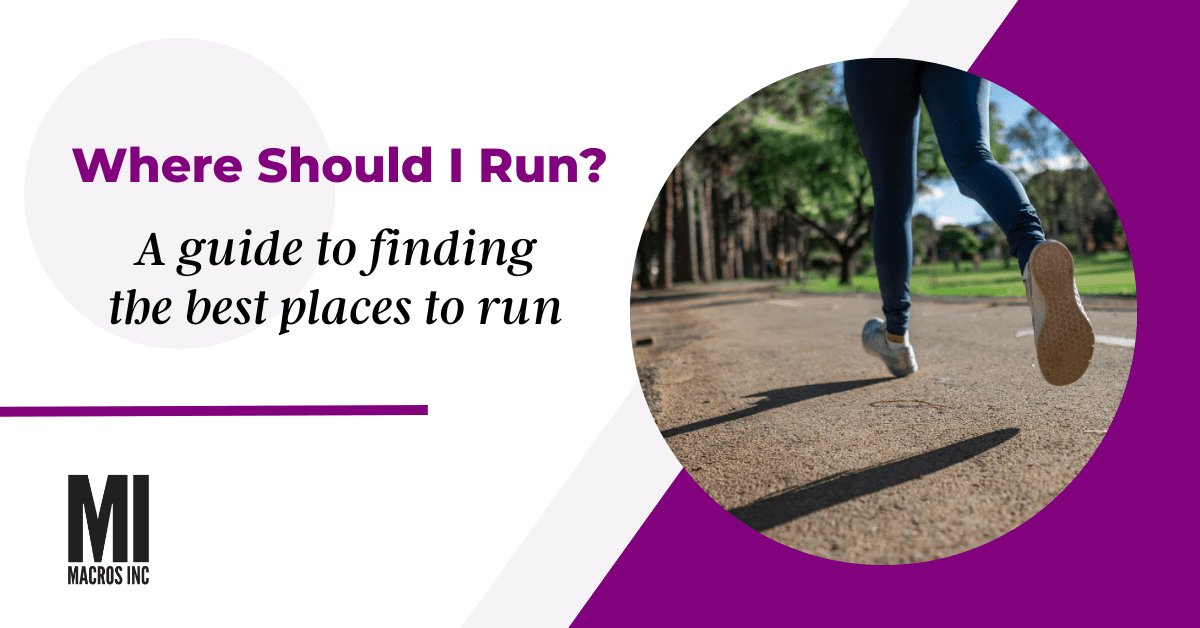By: Ashley Kallman CPT, CN, BCS, BRM, RRCA Cert Running Coach
Choosing the right running shoes is essential for any runner. Not only does it provide the necessary support and cushioning for your feet while running, but it also helps to reduce the risk of injury.
When selecting a running shoe, there are several factors to consider, such as the type of running you will be doing (trail, road, or track), the amount of cushioning you need, and the amount of arch support your feet require. Additionally, it is important to make sure the shoe fits properly, as an ill-fitting shoe can lead to blisters and other foot problems.
Taking the time to research the different types of running shoes available, and trying them on to make sure they fit correctly, will help you find the perfect running shoe for your needs. In this blog post, we’ll provide some tips to help you select the best running shoe for you.
If you’re looking for a full how-to guide to start running, check out that first!
Jump to a Topic
Determine what type of runner you are
There are many types of runners, such as recreational, sprinters, trail runners, and marathoners.
Recreational runners are those who are running for fun or enjoy training for races.
Sprinters are looking for a shoe that can offer extra cushioning and traction when taking off from the starting blocks.
Trail runners should look for a shoe that has a more rugged sole, good grip, and is designed for running on uneven terrain.
Marathoners need a shoe that can handle longer distances without getting worn out but also one that provides maximum cushion and good support.
No matter what type of runner you are, it is important to find a shoe that fits your needs and provides the best support for your feet.
Consider your budget
When it comes to selecting the best running shoe for you, it is important to consider your budget. There is a wide range of shoes on the market, with prices ranging from entry-level to high-end. Higher-end shoes are typically made with higher-quality materials, such as breathable mesh, cushioning, and durable rubber soles.
This means that they may be more expensive than entry-level shoes, but they will provide better support, comfort, and durability. The type of runner you are and the features you need should also be taken into account when considering the price of a shoe. It is important to find a shoe that fits your budget but also provides the features you need for your running goals.
Know your running pronation
When you’re looking for the right running shoe for you, it’s important to consider your pronation. Pronation is the way that your foot rolls when you step down. The type of pronation determines the amount of shock absorption, cushioning, and stability in a running shoe. Depending on your foot type and pronation, you’ll need different features in a shoe.
There are three types of pronation – neutral, overpronation, and underpronation.
Neutral pronation occurs when the outside of the heel strikes the ground and the foot rolls outward slightly. This type of pronation typically works best with neutral cushioned running shoes.
Overpronation occurs when the arch flattens and the foot rolls inward excessively. If you have overpronated feet, you should opt for motion control or stability shoes.
Underpronation (also known as supination) is when the outside of the heel strikes the ground and the foot doesn’t roll inward enough. Shoes with more cushioning are best for those who underpronate.
Some good brands who stock these types of running shoes are Asics, Brooks, Mizuno, HOKA
If you are unsure, visit a running store to determine your pronation type since it will help ensure you buy the right type of shoe for your foot. A qualified salesperson can observe your gait and recommend the best type of shoe for you based on your foot type and pronation.
“I thought that my hip discomfort with longer distance walking was just something I had to deal with but when I went and got fitted for the right shoes for my activity, it was almost like the shoes were helping me walk! That discomfort almost immediately went away and now I can walk even further without pain. Don’t be afraid to go to a store and try on multiple different shoes and try them out around the store.”
-Keshia Cook, Macros Inc coach
12 tips for choosing the best running shoe
Finding the perfect running shoe goes beyond just selecting the right type and features; proper fit is paramount. Ill-fitting shoes can lead to discomfort, blisters, and even injuries. Understanding shoe sizing and fit principles can help ensure you choose a shoe that supports your running goals.
Understand your foot’s anatomy
Before diving into shoe sizing, it’s essential to understand your foot’s anatomy. Your feet are complex structures with unique characteristics. They might have different lengths, widths, and arch shapes. Measuring both feet and noting any differences is crucial.
Get accurate measurements
Shoe sizing varies between brands and even styles, so knowing your measurements is key. You can measure your feet at home using a ruler or a foot measuring device. Measure the length from your heel to your longest toe and the width across the widest part of your foot. Compare these measurements to the sizing chart provided by the shoe manufacturer.
Consider the width
Shoe width plays a significant role in fit. Shoes are often available in different width options, such as narrow (N), regular (D or M), and wide (W). If you have wide feet, choosing a shoe with appropriate width can prevent discomfort and rubbing.
Leave room for toe space
When trying on running shoes, ensure you have about a thumbnail’s width of space between your longest toe and the front of the shoe. This allows room for your feet to expand during the impact of running, preventing toe injuries.
Pay attention to sock choice
When trying on shoes, wear the type of socks you plan to run in. Different sock thickness can influence the fit of the shoe. Wearing the right socks can help you get an accurate feel for how the shoe will fit during your runs.
Consider the lacing technique
Experiment with different lacing techniques to fine-tune the fit. For instance, if you have a narrow heel, using a “heel lock” lacing technique can prevent your foot from slipping inside the shoe.
Visit a specialty running store
While online shopping offers convenience, visiting a specialty running store can provide expert guidance. Knowledgeable staff can analyze your gait, foot shape, and pronation to recommend suitable shoes. They can also assess the fit and offer valuable insights that can make a difference in your comfort and performance.
Try shoes on and test them
Once you’ve narrowed down your options, try on multiple pairs of shoes. Walk around, jog in place, and even simulate running movements if possible. Pay attention to any discomfort, pressure points, or slipping. A good-fitting shoe should feel snug but not tight, and it should offer support and stability.
Consider half sizes and inserts
Sometimes, the perfect fit might require trying a half size larger or smaller than your usual size. Additionally, custom insoles or inserts can enhance comfort and support, especially if you have specific foot conditions.
Update your knowledge regularly
Remember that your foot size and shape can change over time due to factors like weight loss or gain, pregnancy, and aging. It’s a good practice to measure your feet periodically to ensure you’re always wearing the right size.
By understanding these aspects of shoe sizing and fit, you can enhance your running experience and reduce the risk of discomfort and injuries caused by improperly fitting shoes.
Consider the terrain you’ll be running on
The terrain you’ll be running on can play a huge role in determining the best running shoe for you. Whether you’re running on the road or trail, pavement or dirt, the type of terrain you encounter will influence the features you need in your running shoes.
For instance, if you’re running on trails with a lot of rocks and uneven surfaces, you’ll need a rock plate in your sole to protect against sharp objects and provide extra cushioning. Trail shoes usually have a more aggressive sole and a firmer midsole for stability for good grip and traction.
If you’re running on roads and sidewalks, however, you won’t need a rock plate. You’ll want a softer sole for cushioning and a more flexible midsole.
By taking the time to consider the type of terrain you’ll be running on, you’ll be able to make sure you get a shoe that meets your needs and helps you get the most out of your running experience.
Think about the features that are important to you
When it comes to finding the best running shoes for you, consider the features that matter most to you. Look at things like the uppers, which are the materials used to make the top of the shoe.
Uppers can be made from a variety of materials like leather, mesh, and synthetic. The upper can add flexibility to the shoe as your foot moves through the landing and toe-off positions.
Also, look for breathability. Many shoes have mesh panels to allow your feet to breathe and wick away sweat. If you’re running in hot weather, this is especially important.
Finally, check out the cushioning and arch support the shoe offers. Cushioning helps provide shock absorption and arch support helps your feet stay in alignment when running. “The right shoe for you should feel good right out of the box and not require a break-in period.”
And if you’re in need of additional support to achieve your health and fitness goals, find out more about our coaching service.
Try our nutrition coaching, for free!
Be the next success story. Over 30,000 have trusted Macros Inc to transform their health.
Simply fill out the form below to start your 14-day risk-free journey. Let's achieve your goals together!


